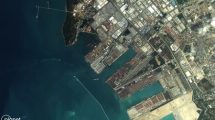
The number of satellite communication terminals in the global maritime market will nearly double over the next decade, with an estimated CAGR of 7%, according to experts. We look at the challenges and opportunities in catering to the growing demand for bandwidth in the marine sector.
It does not take much for the owner or captain of a leisure boat to be happy. The chef should be up and about, the air conditioners and toilets should be functioning and internet connection should be working. Unlike the other parameters for impermanent bliss, the internet connection comes with a number of qualifiers – how fast is the connection, who is getting the connection and how much is this costing me?
When Costas Charalambous, sales director and his team at Cyprus-based Global Marine Communications (GMC) deploy VSAT-based solutions on a boat, they know that the service is about more than providing basic connectivity.
Speaking to SatellitePro ME at the recently concluded Dubai International Boat Show, the marine Satcom solutions provider said, “It is not just about delivering internet service, the service has also to be distributed in a way that works for the boat owners.”
When Costas’ team deploys a VSAT-based connectivity powered by Hughes, he also provides a bandwidth management system called BOSS (bandwidth optimisation and security server). “The acronym is quite apt, because it helps manage the system. We do not know what sites are being visited because that is a privacy issue, but we do know that the user is downloading three megabytes, for instance. It helps the owner distribute the bandwidth between various users depending on criticality and other criteria.”

One size does not fit all
“We offer dedicated airtime packages that deliver full speed, off the link, designed for real time applications like VOIP, video or real time monitoring and these tend to be the highest cost solutions,” explains Costas. He adds, “The shared or contended capacity airtime packages allow multiple vessels to use the same capacity therefore significantly reducing service cost.”
The difference in price can be astronomical, says Costas.”You can have a contended service (contended 5:1) for a price of Euros 800 a month or a dedicated line that could cost anywhere between Euros 4,000, 5,000 or more.”
Costas and his counterparts in the industry serve a sector that has the cost-be-damned, oil rich prince as a customer who would pay Euros 4,000 per month for unlimited and dedicated connectivity to a boat he seldom visits and the cost-conscious charter cruise owner in a recession-driven, uncertain economy.
Word of mouth is crucial and it does not getter any better than when the owner of a boat recommends your service to his friends
Working closely with resellers in individual markets, Costas is mindful of the importance of the personal touch. “Word of mouth is crucial and it does not getter any better when the owner of a boat recommends your service to his friends.”
Technology drives demand amongst a discerning customer base
Technology also matters as customers grow more discerning, Katrin Haessner, managing director of Germany-based Epak explained. “We established an office in the UAE primarily because we realised the boating fraternity here appreciates German technology. I think we were the first to introduce the 60 cm antenna in the region. Back home in Germany, we started, in 2000, with TV antennas for the yachting sector. In the past few years, we have been supplying antennas to commercial clients such as fishing boats, oil and gas and a growing customer base in the river cruise sector.”
Historically, marine Satcom developed faster because of the longer journeys as compared to air or on ground and larger antennas were developed to cater typically to oil rigs, tankers, ferries, and so on. It was the development of the small sized Ku-band antennas at a relatively low cost, that allowed for connectivity on smaller sized vessels.
Haessner’s company boasts of what is reportedly the world’s smallest 2-way satellite communication antenna for the Ku-band with a reflector size of 60 cm (24”) that guarantees an extremely fast internet access with 2048 kBit/s downlink and 512 kBit/s uplink. “Once the ship starts to move, our antenna tracks the satellite 80 times per second,” she claimed pointing to the antennas on display. Despite ensuring technological superiority and compliance with international standards, operations such as Epak, though being based in the region, close to its customer base, faces challenges.
With regard to challenges, we are not referring to the issues raised by experts about the pervading lack of importance given to type approval of mobile Satcom systems. Antenna size, adjacent satellite interference and the need for type approval…that is clearly another editorial feature altogether.

Challenges posed by the cost-conscious customer
Mariners no longer want to pay by the byte as was the case in the past with L-band technology. The higher frequency Ku-band made it possible for low, fixed-price broadband.
Service providers are now coming up with creative packages for a market largely driven by buyers. Haessner says, “There is a market demand for lease and we offer that. We offer both short term and long term rental and we’ve seen our competition has followed suit in this region. Normally customers pay a flat rate for connection, but some customers in the yachting sector opt for a volume-based contract which allows them a certain limit for a month. Once they reach this limit, we notify them by email.”
Because of the low purchase costs and monthly fees for this new generation of antennas, which are much below the usual costs in the market, an affordable maritime internet service is possible
She added, “ Because of the low purchase costs and monthly fees for this new generation of antennas, which are much below the usual costs in the market, an affordable maritime internet service is possible.”
Continuing on the all-important aspect of cost, Costas says, “Undercutting is an issue. But I think it is more about trying to educate the customer. I try to explain the importance of contention ratio. When customers tell me that they are getting the connection at a lower price with a contention ratio of 10:1, I explain to them that there are nine other people using that same link. In Europe, for instance, from March to October everyone is in the South of France, accessing the internet. So for a 5:1 contention ratio, you may be paying higher, but you are getting double the speed. It is easier when you deal with resellers or captains who understand this. With management companies, the whole issue of CAPEX vs. OPEX comes into play.”
And with a view to retaining customers, systems are kept as user-friendly as possible, Haessner says, “Our antennas are simple to operate and maintain. If a cable is broken, the dealer or a trained person on the ship is able to solve the problem in a few steps. In addition, we have training facilities here in our office, in the UAE, for our resellers and customers.”
Working closely with service providers
Fully recognising the delicate balancing act the value chain is for all the players, Kyle Hurst in his relatively new role as director, market development – maritime, Thuraya, spoke of the importance of strengthening the network of service providers in the marine sector. He says, “While we are committed to our indirect distribution, we work closely with our marine service providers. They know their customer and their requirements. I am in touch with them on a regular basis – sometimes daily with a couple of them. This helps us know what each one is doing and it helps in devising solutions for customers, if need be.”
With extensive experience in the marine sector, Hurst knows the industry has evolved beyond providing just the equipment. He says, “We want to offer, in collaboration with our partners, complete solutions. We are concentrating on products and the range of services coming out of the products. Why I stress this is because we are beyond an era, in the maritime sector, when all you needed to do was to sell a piece of equipment.”
Hurst describes the year 2012 as pivotal with Thuraya moving beyond narrowband to include solutions for voice and broadband.
Providing the spectrum of solutions is key, say Hurst, when he says: “While the end user is looking for rugged, effective solutions at the right price they are also looking at the cost of ownership over a period of years. In addition, boats are constantly upgrading their connectivity. We are looking at products that we can offer across the entire spectrum, from simple voice communications to broadband office communications – so you can actually have your vessel operating as part of your corporate network.“
He sees business coming from various sectors. “On the merchant shipping side of things, quite a few ships are moving from older technology to newer technology because of costs and throughput. While they may have relied on voice and thin data connection for email, they are now looking for complete communication systems. In fisheries, there is a lot of pressure with national regulations. From simple tracking systems to more advanced measures of monitoring, governments and fishery boards are trying to protect their marine resources. On the leisure side, people expect to be connected on the boat just as they are on land. We are trying to push effective solutions in each of these verticals.” With products such as the Seagull 5000i terminal that has tracking functionality, which is becoming a mandatory requirement by many maritime and fishery bodies, Hurst agrees that the company is well placed to tap into the fishery sector, in particular.
Categorising criticality of data
Like Costas, Hurst agrees that the connection is only part of job done. He says, “The pipe is only half the job, the other half is ensuring that critical ship clearance gets through before a crew member’s email to friends. Currently, we offer 444 kilobits per second as the capacity of our network. This is more than enough for the operational requirement of most vessels. It all comes down to how critical the data is and how much you are willing to pay for the connection.
The pipe is only half the job, the other half is ensuring that critical ship clearance gets through before a crew member’s email to friends
“Operational traffic is typically critical, followed by administrative and crew data. That is why we are concentrating on ‘all you can eat’ packages. You pay a set fee per month that is fit for purpose for whatever you want to do. If you know the capability you are getting, you can then decide to plan your data around that and decide that when it comes to obtaining clearance to enter national waters, communication cannot be down on any account, for which you would opt for a highly redundant, possibly, L-band based solution.”
He adds, “We work closely with our service partners because our success is determined by them. We’re just putting together partner support programmes and setting up new facilities in the Thuraya building to run through what our service partners are offering and find out how we can be more effective in supporting them. “
Downward pressure on price and historic highs in demand
Coupled with global recession, the marine sector has seen a downward pressure on price prompted by large providers/operators consolidating their operations. With the acquisition of ShipEquip, a large provider of maritime VSAT, Inmarsat is able to offer Ku-band service, along with its FleetBroadband for L-band, as a backup. This has triggered a price war among Satcom service providers. To counter this, EADS Astrium’s acquisition of Vizada, which owns Marlink, saw a further price reduction.
As customers are becoming more price sensitive, focusing on free equipment and airtime packages, the bright spot is that the demand for connectivity has never been higher. For instance, analysts view the factors driving the MSS growth in Asia- Pacific will primarily be the maritime sector, due to an increase in maritime trade on the back of solid economic development and the presence of major ports. The number of maritime terminals is expected to grow to over 123,000 units and the annual wholesale revenue is forecasted to reach US$ 212 million in 2018.
The demand for low-cost, ship-to-shore communication, is also triggered by the pressing need to retain valuable labour. In addition, the recession is prompting the need for greater efficiency.
Hurst says, “You still need to carry cargo. There are larger costs than communication, with fuel and crew being a big part of that. If I can spend 20% more on critical communication that can save me fuel and help me retain crew… that is the sort of dynamics coming into play within the vertical. Yes, people cut down on budgets but also seek optimisation.”
Ka-band: The emerging disruption
In the mix is the imminent entry of Ka-band. Costas says, ‘The new kid on the block, will be Ka-band services which will offer even higher speeds. Perhaps up to 20 Mbps and at a reduced cost/Mbps. In the leisure industry, Ka-band will probably be used as an ancillary service to Ku-band to boost the user experience when in home waters or be used on vessels that rarely travel more than 100 kms from the home port.” The product innovators have already responded with dual-band (Ku-Ka) antennas.
Haessner agrees that Ka-band can revolutionise the industry. She says, “While Ka-band enables narrower beams allowing more reuse of frequencies and higher power, it also requires greater precision in the manufacture of antennas and more sophisticated electronics to cope with rain fade and so on. The impact on cost and performance will have to be studied. Having said that, we will definitely see changes in the coming years.”
Costas believes that the increasing complexity of a ship’s IT infrastructure can no longer be left to just evolve. He says, ‘A slow or flaky internet connection will not be tolerated in the future and so services such as network infrastructure audits and bandwidth management solution must form part of what a ship demands from its internet service provider.”












Add Comment